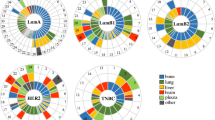Abstract
There is growing evidence about differences in metastatic spread among breast cancer (BC) biologic subtypes (BS). Aim of this study was to analyze the pattern of metastasization according to BS and to explore the corresponding prognosis. A series of 544 consecutive patients receiving anticancer therapy for metastatic BC from 2004 to 2013, was analyzed. BS were defined by immunohistochemistry according to St Gallen 2013 criteria. Association between BS and the different distant localizations was analyzed. Prognosis was described in terms of overall survival (OS), progression free survival (PFS) and post progression survival (PPS). Results were reported taking luminal A BC as reference. Triple negative BC showed a higher tropism for lung (OR 4.30 95 % CI 1.41–13.1), while non luminal HER2 subtype was associated with a higher rate of liver metastases (OR 3.61 95 % CI 1.36–9.58). All subtypes were associated with a lower risk of bone-only localization. Central nervous system (CNS) involvement was more common in HER2 positive BC (OR 6.3, 95 % CI 1.08–36.66). Liver, lung and CNS involvement influenced negatively OS (HR 1.64, 95 % CI 1.29–2.07; HR 1.49, 95 % CI 1.18–1.90; HR 2.891, 95 % CI 1.85–4.51, respectively) and PFS (HR 1.39, 95 % CI 1.13–1.71; HR 1.26, 95 % CI 1.02–1.55; HR 1.75, 95 % CI 1.12–2.71, respectively). Multivariate analysis confirmed liver involvement as independent predictor of worse OS (HR 1.64, 95 % CI 1.15–2.34). Stratification by metastatic pattern showed significant differences in terms of PPS but not in terms of PFS. The study suggests that BS may be characterized by typical patterns of metastatic spread and have different impact on clinical outcome.


Similar content being viewed by others
References
Jemal A, Bray F, Center MM et al (2011) Global cancer statistics. CA Cancer J Clin 61:69–90. doi:10.3322/caac.20107
Sihto H, Lundin J, Lundin M et al (2011) Breast cancer biological subtypes and protein expression predict for the preferential distant metastasis sites: a nationwide cohort study. Breast Cancer Res BCR 13:R87. doi:10.1186/bcr2944
El Saghir NS, Tfayli A, Hatoum HA et al (2011) Treatment of metastatic breast cancer: state-of-the-art, subtypes and perspectives. Crit Rev Oncol Hematol 80:433–449. doi:10.1016/j.critrevonc.2011.01.010
Bonotto M, Gerratana L, Poletto E et al (2014) Measures of outcome in metastatic breast cancer: insights from a real-world scenario. Oncologist 19:608–615. doi:10.1634/theoncologist.2014-0002
Khodari W, Sedrati A, Naisse I et al (2013) Impact of loco-regional treatment on metastatic breast cancer outcome: a review. Crit Rev Oncol Hematol 87:69–79. doi:10.1016/j.critrevonc.2012.12.005
Redig AJ, McAllister SS (2013) Breast cancer as a systemic disease: a view of metastasis. J Intern Med 274:113–126. doi:10.1111/joim.12084
Kennecke H, Yerushalmi R, Woods R et al (2010) Metastatic behavior of breast cancer subtypes. J Clin Oncol 28:3271–3277. doi:10.1200/JCO.2009.25.9820
Berman AT, Thukral AD, Hwang W-T et al (2013) Incidence and patterns of distant metastases for patients with early-stage breast cancer after breast conservation treatment. Clin Breast Cancer 13:88–94. doi:10.1016/j.clbc.2012.11.001
Park S, Koo JS, Kim MS et al (2012) Characteristics and outcomes according to molecular subtypes of breast cancer as classified by a panel of four biomarkers using immunohistochemistry. Breast 21:50–57. doi:10.1016/j.breast.2011.07.008
Lam SW, Jimenez CR, Boven E (2014) Breast cancer classification by proteomic technologies: current state of knowledge. Cancer Treat Rev 40:129–138. doi:10.1016/j.ctrv.2013.06.006
Goldhirsch A, Winer EP, Coates AS et al (2013) Personalizing the treatment of women with early breast cancer: highlights of the St Gallen international expert consensus on the primary therapy of early breast cancer 2013. Ann Oncol 24:2206–2223. doi:10.1093/annonc/mdt303
Prat A, Cheang MCU, Martín M et al (2013) Prognostic significance of progesterone receptor-positive tumor cells within immunohistochemically defined luminal A breast cancer. J Clin Oncol 31:203–209. doi:10.1200/JCO.2012.43.4134
Park YH, Lee S, Cho EY et al (2010) Patterns of relapse and metastatic spread in HER2-overexpressing breast cancer according to estrogen receptor status. Cancer Chemother Pharmacol 66:507–516. doi:10.1007/s00280-009-1190-7
Minisini AM, Moroso S, Gerratana L et al (2013) Risk factors and survival outcomes in patients with brain metastases from breast cancer. Clin Exp Metastasis. doi:10.1007/s10585-013-9594-5
Metzger-Filho O, Sun Z, Viale G et al (2013) Patterns of recurrence and outcome according to breast cancer subtypes in lymph node-negative disease: results from international breast cancer study group trials VIII and IX. J Clin Oncol 31:3083–3090. doi:10.1200/JCO.2012.46.1574
Puglisi F, Fontanella C, Numico G et al (2014) Follow-up of patients with early breast cancer: is it time to rewrite the story? Crit Rev Oncol Hematol 91:130–141. doi:10.1016/j.critrevonc.2014.03.001
Heitz F, Harter P, Lueck H-J et al (2009) Triple-negative and HER2-overexpressing breast cancers exhibit an elevated risk and an earlier occurrence of cerebral metastases. Eur J Cancer Oxf Engl 45:2792–2798. doi:10.1016/j.ejca.2009.06.027
Dawood S, Broglio K, Ensor J et al (2010) Survival differences among women with de novo stage IV and relapsed breast cancer. Ann Oncol 21:2169–2174. doi:10.1093/annonc/mdq220
Yardley DA, Kaufman PA, Brufsky A et al (2014) Treatment patterns and clinical outcomes for patients with de novo versus recurrent HER2-positive metastatic breast cancer. Breast Cancer Res Treat 145:725–734. doi:10.1007/s10549-014-2916-8
Conflict of interest
The authors have declared no conflicts of interest.
Author information
Authors and Affiliations
Corresponding author
Rights and permissions
About this article
Cite this article
Gerratana, L., Fanotto, V., Bonotto, M. et al. Pattern of metastasis and outcome in patients with breast cancer. Clin Exp Metastasis 32, 125–133 (2015). https://doi.org/10.1007/s10585-015-9697-2
Received:
Accepted:
Published:
Issue Date:
DOI: https://doi.org/10.1007/s10585-015-9697-2




